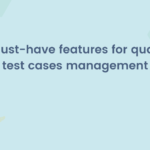
About AGH University
AGH University of Science and Technology is a technical university in Poland, located in Kraków. It has 15 faculties. In 2019, AGH was selected as the fourth-best university in Poland and the second-best technical one by the most recognized Polish university ranking.
One of the fields of study, Software Quality Engineering aims to teach students how to assure the best quality of IT systems using modern tools and good practices. The program includes gaining practical knowledge about testing, project management, and test automation. During courses, participants test a dedicated app in the Agile methodology which is now the most popular project management model in IT companies and software houses.
Subjects during studies match the requirements of the ISTQB certificate. By the end of the semester, students can proceed to the ISTQB® Certified Tester – Foundation Level exam which is often highly valued whilst searching for a job in the testing industry.
The challenge of separated tasks and unintuitive interface
The first solution used by students and lecturers was TestLink – an external tool for test management. Unfortunately, it turned out to be rather complicated to use:
- 1. The first and most important issue was that it required additional training from students, as the look and feel of TestLink wasn’t familiar to most of the participants. Additionally, the software wasn’t intuitive, so it was difficult for fresh testers to get on with it right away.
- 2. Although the tool supports the organization of tests, it didn’t meet the expectations and needs of both groups: teachers and future engineers.
- 3. It is a separate tool to begin with, which has to be installed, configured, and presented to a large group of people. This whole initial process is usually time-consuming and the time during the courses should be seriously valued.
This is when Grzegorz Szczutkowski, IT lecturer at AGH, decided on trying Requirements and Test Management for Jira (RTM). His experience allowed Grzegorz to pick Atlassian’s Jira as the best solution for AGH. Not only it simplifies everyday tasks and work in the Agile model, but it’s also used in the majority of enterprises, so students could be well prepared to go and work in the real world right after the end of their studies. RTM for Jira itself was chosen to promote a national solution – and everyone really appreciated the change.
Why RTM for Jira turned out to be the solution?
Familiar interface
Requirements and Test Management for Jira is an extension to a commonly known tool, so it was already familiar to many students. If not, the participants could learn two useful things at a time – Jira as well as the test management app. RTM is designed to be intuitive and user-friendly, but also fully functional. It guides users step by step through the whole testing process – from gathering requirements to reporting defects. For this reason, students understood it much faster than it was in the case of the previous tool.
Built-in requirements management
Usually, when it comes to testing software, collecting requirements is excluded or managed in an external tool. This is a mistake that can bring lots of chaos into the work, especially when the team is dealing with big projects or numerous people involved like it’s in the case of AGH students. One of the greatest advantages of RTM for Jira is that requirements are directly linked to the rest of the testing activities and managed together. Each one has a defined type, title, and description. It certainly helps beginners understand the logic and consistency of testing.
Traceability of testing objects
As all the objects, including requirements, test cases, test plans, test executions, and defects are linked, it is easy for students to find out which elements result from which. We are all familiar with something called the human factor – it’s quite common when one learns new things. Even if a student is focused, the risk of omitting something by accident is very high. Requirements and Test Management app displays relations between the testing elements, so the participants can make sure everything is covered and taken care of before they start executing the test plan. What’s more, it’s much easier for the lecturers to track the progress of each test case and test plan execution. They can easily filter which issues are failed or how many are already done/in progress.
Catalog easy to order
Thanks to the transparent tree-structured view, students can organize the objects, starting with requirements. They can be cataloged by functionality, environment, priority, assignee, or any other way testers and lecturers see fit. This feature allows building a clear hierarchy of tasks for the team as well as customers. The folders and subfolders enable assigning issues to the right people, systematizing the process, verifying the results, and monitoring the progress of a group of tasks. If testing objects are well-structured and divided, it’s easier to do risk analysis and time estimations. Also, students can only select the tasks they’re interested in by choosing an assignee or by component/label/version field.
Intuitive fields to fill in
Future test engineers create test cases that cover specific requirements. A well-described test case includes title, general description, labels, preconditions, and of course a list of test steps with expected results. RTM for Jira has dedicated fields for each testing object and its components, so a student can just fill in the necessary information and be sure that nothing is being forgotten in the process. It works equally in the case of tests, requirements, plans, executions, and defects. Even beginners will know what to do at each stage – and if the whole team cooperates, it certainly leads to better overall results.
Good practices from the very beginning of testing
The first crucial problem that was fixed thanks to deciding on Requirements and Test Management for Jira is a time issue. Before, it took days to explain how TestLink works and then some more time until all students really understood how to manage a new tool. RTM is much more intuitive – Grzegorz Szczutkowski confirms that even participants without any experience with Jira get along with it much faster.
Additionally, using RTM for Jira during studies enables lecturers to teach the participants good practices that they will benefit from in their future career paths. The app offers ready-to-go solutions: step-by-step navigation, fields that just have to be completed, and real-time, flexible reports that allow one to only present the information one needs. Even if students will have to work on another testing tool after the course, the things learned in RTM will help them keep order in their area and cooperate with the other team members.
If you feel that Requirements and Test Management could also work you – don’t hesitate and book a free live demo via Calendly – we will be more than happy to answer all your questions.


